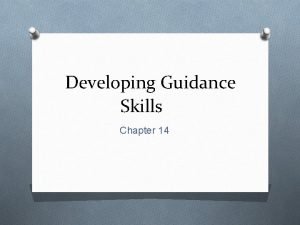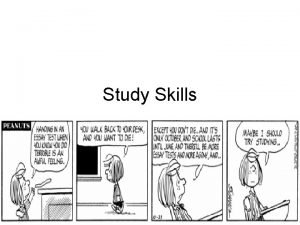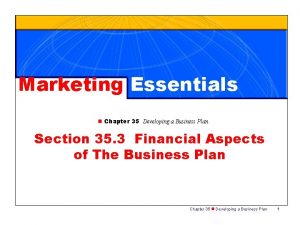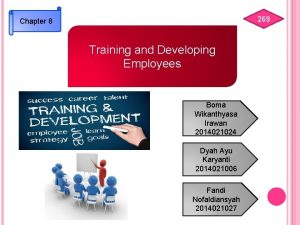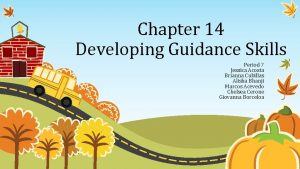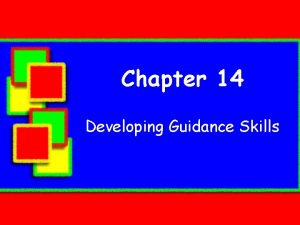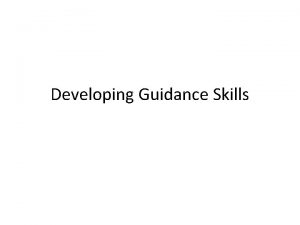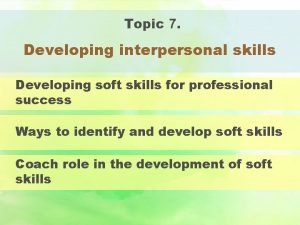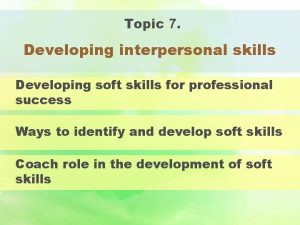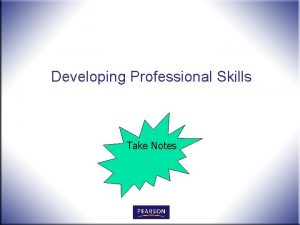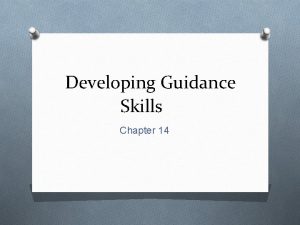Chapter 14 Developing Guidance Skills Period 7 Jessica
















































- Slides: 48

Chapter 14 Developing Guidance Skills Period 7 Jessica Acosta Brianna Cubillas Alisha Bhanji Marcos Acevedo Chelsea Cerone Giovanna Borceloa

Discipline: Guidance Vs Punishment • Discipline: training that develops self-control. • Guidance: consists of direct and indirect actions used by an adult to help children develop internal controls and appropriate behavior patterns. - Helps children learn to take responsibility for their actions. - Teaches children the difference between acceptable and unacceptable behavior. • Punishment: a form of discipline that does little to respect children. - Focuses on the use of unreasonable, often harsh, actions to force children in to behaving the way adults want.

Goals of Guidance • Effective guidance should maintain children's self esteem. • A positive desired change in behavior should be produced • Long-term goals of guidance are self-regulation and self control • Children should learn to direct their own behavior without outside control • Prosocial Behaviors- are acts of kindness that benefit others • Examples: - Accepting/respecting others feelings -verbally/physically comforting others -helpfulness -cooperating -affectionate

Guidance and You • The teacher’s personality affects the children’s behavior. • Children respond faster to suggestions rather than commands. • Teachers should ask open-minded questions since they require more than a oneword answer. As a result, the children will show positive characteristics. • Teachers must be a good role model and set a good example for the children to follow. • An uncooperative teacher results in hyperactive and bored children. • Children who have a talkative teacher tend to be more shy. • A teacher’s lack of involvement can result in aggressive, attention-seeking behavior.

Preparing for Guidance • The first step towards an effective guidance is observations of the children • While your observing the children, you should take note how a child behaves in a certain situation. This will help you in understanding the children in your class • Always ask yourself questions • Stereotypes hold an affect of your perception of a child • If you want to be more objective you have to be honest about your own attitudes and how they may influence your interactions

Cultural Variations v v v v Cultural variations is like nonverbal behavior Nonverbal behavior is when a child uses actions instead of words Examples include: facial expression, eye contact, touch, and gestures Children gain a lot of their knowledge from nonverbal actions Smaller children use nonverbal actions to know how to behave around adults Someone's cultural values can change their ideas of proper child guidance Getting close to a child's parents can help you understand a child better

Sharing observations • Sharing observations, feelings, and suggestions with other teachers will help you better understand children • Children should always come first so avoid talking to staff unless its an emergency • Sit with children whenever possible, they will find it easier to approach you • Let children come to you, this with help develop independence. • * NEVER DO FOR THE CHILDREN WHAT THEY CAN DO FOR THEMSELVES*

DEVELOPING GUIDANCE SKILLS By: Gabriella Fernandez , Joselyn Espin , Giulianna Faillace , Isabella Estrada , Sofia Diaz, Johann Dobrowolski and Jonathan Delafe

Direct Guidance By: Giulianna Faillace • Child guidance may be Direct or Indirect. • Indirect Guidance: involves outside factors that influence behavior • Examples- • The setup of the classroom areas to move easily, low shelves, low bathroom facilities, low hooks. • Labeling shelves or units with a picture of what belongs in that area. • Direct Guidance: involves nonverbal (physical) and verbal actions. • Examples of nonverbal actions: body/facial gestures such as eye contact, a smile, or even a surprised look. • *your words should always match your nonverbal signals* • Examples of Direct guidance: • Telling a child his drawing is great! • Putting your arm around a child • Waving goodbye at a child

Use simple language By: Isabella Estrada • Use language that young children will understand to communicate with ease • Consider age of children and adjust vocabulary to their comprehension level • This typically depends on their level of development more so than the age • Ex: The toy is big • 2 year olds- big • 3 year olds- large • 4 -5 year olds- huge

Speak In A Relaxed Voice By: Jonathan • Speak in a calm, quiet, relaxed tone of voice. Children listen to this type of voice. • Loud, high-pitched voices are better for emergencies. These voices are associated with strong emotion. • If you are always talking in a loud voice the Children will get used to that so when there is a real emergency the children think it's just a regular day.

Be Positive By: Joselyn Espin • Guide children by telling them what to do instead of what not to do. • EX: Instead of telling a child "Don't paint on the carpet. " Tell them "Paint on the table please. "

Offer Choices With Care BY : GABRIELLA FERNANDEZ • Sometimes teachers confuse offering a choice with giving direction. • Children should be given a choice only when you want them to - ex. "Do you want to go in for lunch A better directive would be "It is - time for lunch now" • When giving the child a choice you should ALWAYS continue with his or her decision.

Encourage Independence and Cooperation • Try to give the child the least amount of help By: Sofia Diaz • Encourage younger children to dress, feed, and complete their responsibilities • Children only become independent if you let them • Teachers and parents cannot pick up after a child because the child will begin to depend on the adults • These experiences help the children to learn prosocial behavior

Be Firm By: Gabriella Fernandez • When discipling children you should be firm. • At the same you should keep your voice at a calming level. • Although, some children you may not be able to gain their attention. • Additionally, when the teacher raises their voice , the students will too, and the classroom will become a noisy environment.

Be Consistent By: Sofia Diaz • Children are good at testing adults • Be consistent in disciplinning therefore the child will not repeat their unacceptable • Being consistent means do not discipline a child one day and praise him or her the next day • Keep consistency between children • Children can sense favoritism between children. • When they are favorites then the child will challenge the adults request

Provide Time For Change By: Isabella Estrada • With each activity, ample time should be provided to young children to accomm odate to new activities and new surroundings • Without this time, children can get easily confused and may get frustrated with themselves a nd won’t be as receptive to directions or information • Ex: Children going out into the cold should be provided time to put on their coat s, hats, and mittens on

Considering Feelings Johann Dobrowolski • Something that is not always included in daily lesson plans are learing about feelings and emotions which is an important part of any early childhood program • Children need to learn how to recognize, understand, and learn to express their feelings • The feelings they could be feeling might relate to their bodies, siblings, eating, freindships, and toileting • Feelings are best discussed in small groups settings or alone with a child, some children find it difficult talking about feelings • It's your responsibility to help them understand express their feelings

Intervening WITH YOUNG CHILDREN Group 3

What to do? • Remind the child to share. (in property arguments) • Give the equipment to one child for a set time period, then give it to the other child.

Indirect guidance • Indirect guidance involves outside factors that influence behaviors. • For example, a school affecting how students and teachers act. • The children will feel safer knowing they are being protected. • In order to properly supervise a classroom, you should be able to see the entire class and observe and give help when needed. • For example, a big, spacious classroom where everything can be seen can prevent dangerous accidents.

Encouragement skills for kids • Children's independence can be encouraged through the physical setup of the facility. • Encouraging children to clean up is a good skill to acquire for their adult lives.

Examples FOR encouraging children • Low shelves and sinks will encourage children to help clean up. • Placing a picture of the items on a shelf or container is one way of assisting the children. • These arrangements will not only save you time, but can teach the kids life skills.

DEVELOPING GUIDANCE SKILLS Stephany Magdariaga Sophia Lopez Sophia Milan Sean Moreno Jealiet Lamon Armando Longueria Leidys Martinez

Techniques for effective guidance • -teach children acceptable behaviors. Likewise , the children in your classroom will also teach other. • Some guidance techniques are: • Positive verbal environment • Using positive reinforcement • Using consequences • Warning • Time-out • I-messages

Positive verbal environment • -the verbal environment includes all the communication that occurs within setting Positive verbal environment include: • Can be made by an adult or child. • Includes nonverbal communication of actions rather than words. (ex. Eye contact, facial expressions, gestures & touch) • Teachers can help create a positive verbal environment by using active listening skills. (ex. Engaging in conversations & using children names) • Be polite. Use words such as thank you, please & excuse me.

Positive reinforcement • rewarding positive behavior can help mold children's behavior. • For instance: • Thanking the child for holding the door –the child will most likely hold the door again. • Positive messages will encourage the child to repeat the behavior • You must be careful when using positive reinforcement that you are rewarding behaviors you want the child to repeat. Teachers sometimes do not realize they are rewarding children for unacceptable behavior. (ex. Laughing at a child who is acting silly at group time. )

Using consequences • important in molding Childs behaviors • A consequence is a result that follows an action or behavior • There are two types of consequences • Natural • Logical • Natural consequences: doesn’t require anyone's interaction. Experiences that follow naturally because of a behavior. • Logical consequences: when the child is deliberately set up by an adult to show what they will happen if a limit is not followed.

WARNING • WHEN CHILDREN FAIL TO FOLLOW A LIMIT , YOU MUST REMIND THEM THAT THEY ARE MISBEHAVING & THEIR BEHAVIOR WILL HAVE CONSEQUENCES. • Some examples include: • Joel, sand needs to be kept in the sand box. If you throw it again , you will lose your turn. • Tunder, either choose a place in the circle, or I will choose one for you. • These warnings provide children an opportunity to change their behavior. after giving the warning, provide time for the child to comply. If the child doesn’t comply, follow through with consequences

Time-out • a guidance technique which involves moving a child to a quiet place by themselves for a small amount of time usually use • Time out is used when a child's disruption behavior cannot be ignored. In some classes teachers give out time-outs when a child is out of control with anger, this is done to calm the child and also protect the other students from the angry child. • To be effective, tell the children in advance what behaviors will result in time-out. • Time-out should never be used as a form of punishment.

I-Messages • When a child misbehaves, use an I-message to communicate your perceptions and feelings. An I-messages tells a child how you feel about his or her behavior in a respectful manner. An Imessage shows the child how his actions are perceived. • I-message statements should include: • The child's behavior • Your feelings about the behavior • The effects of the behavior • After the I-message you should then say what you want done. • example : "when I see you hitting I am unhappy because you are hurting him. I want you to stop hitting yasser. " • An I-MESSAGE SHOWS THE CHILD HOW HIS ACTIONS ARE PERCEIVED.

Effective Praise • Effective praise is sincere and constructive. It is specific and individualized to fit the situation and child. • Effective praise recognizes the child's positive behaviors and encourages the child to persist at a task. • The goal of effective praise is to make the child feel competent and valued. Young children thrive on effective praise.

Developing Guidance Skills Group 5

Suggesting • Placing thoughts for consideration into children's minds. • make positive suggestions • Lead children's thoughts and feelings into desirable directions • use suggestions multiple times each day in order to mold behavior

Prompting • Children need prompting to stop an unacceptable action or behavior. • verbal or non-verbal. • Verbal Ex. “Moses do you remember where we keep the play dough? ” • Non-verbal Ex. "You can place your finger of your lip and you can say "quiet please!” • praise their good behavior if they listen

Persuading • Encourage children to act or behave in a certain way by appealing to their basic wants and needs • Seeing things from their point of view will give you an idea on how to the approach a situation • You can persuade an interfering child by helping them understand the other child's feelings.

Redirecting • Means to divert, or turn the child’s attention in a different direction • One way to redirect is through distraction • The key to redirecting is providing an appealing substitute • An example would be to give a toy or sing a song to a crying child

Modeling • Children learn by imitating others. • When they observe their surroundings and other behaviors, they are most likely to act the same way. • It involves both verbal and nonverbal actions. Like speaking or sing and dancing or touching.

Listening • Listening involves giving children your full attention. • active listening is to listen to what the child is telling you and respond to the child by repeating what was just said • Active listening is a nonverbal skill that helps children develop self-esteem.

Working With Young Children Group 6

How To Guide Children • Admit your own mistakes • Help children learn how to acknowledge feelings • Be a good listener • Recognize children’s accomplishments • Use proper manners

Ignoring • When a child is able to gain your attention by whining, crying, or throwing a temper tantrum, you have reinforced the child’s behavior. *Do not encourage inappropriate behavior. • If a child’s inappropriate behavior is not dangerous, avoid giving the child attention. • Ignoring is inappropriate when the child’s behavior is harmful, either verbally or physically, to the child or others.

Encouraging • Encouraging is a guidance technique that helps children believe in themselves. • Examples of encouraging phrases: • -You can do it all by yourself! -You were able to do it last week. • -You know how it works. -You must be pleased. • -I know you can fix it

Promoting a Positive Self-Concept • When guiding children’s behavior, your actions should always promote a positive self-concept in each child. • A child’s self-concept includes the qualities the child believes he or she possesses. • It is a result of beliefs, feelings, and perceptions a child has of himself or herself. • Children’s self-concepts reflect the feelings others have for them and the confidence they have in themselves.

Self-esteem • During early childhood, another part of the self-concept emerges. This is selfesteem. • Children’s self-esteem is mirrored in their behavior. A child who lacks confidence may reveal feelings of inadequacy. • Children with positive self-esteem perceive themselves as able and important. They accept and respect themselves as well as others. • A child with a healthy self-esteem is not afraid to explore new and different types of play.

Self-esteem part II • You can promote or undermine a child’s self-esteem by your words or actions. In many subtle ways, a teacher affects how children feel about themselves. • For instance, you may need a child to be quiet. Consider the message the children will receive. If you ask them to be quiet because they are too noisy, they may feel they are bad people because they make too much noise. If you ask them to make less noise because it is disturbing you, the children see they can help you by being quiet.

Self-esteem part III • Every day you provide subtle messages in the form of verbal and nonverbal feedback. These signals can either promote or decrease children’s sense of self-esteem. • You can make children feel appreciated, worthy, loved, and secure by being accepting, concerned, and respectful. • Helping young children grow to respect themselves, as well as others, is not easy. • A child’s self-concept is reflected in his or her stress-coping abilities. Gradually they learn that their lives are influenced by the choices they make. Moreover, they learn that all choices have consequences.

THE END!
 Indirect guidance
Indirect guidance Developing guidance skills chapter 14
Developing guidance skills chapter 14 Chapter 17:3 completing job application forms
Chapter 17:3 completing job application forms Unilateral balanced occlusion
Unilateral balanced occlusion Developing effective study habits
Developing effective study habits Aristo grammar and usage (set b answer)
Aristo grammar and usage (set b answer) Reading techniques and strategies
Reading techniques and strategies Developing facilitation skills
Developing facilitation skills Cynthia lightfoot
Cynthia lightfoot Absolute refractory period and relative refractory period
Absolute refractory period and relative refractory period Absolute refractory period and relative refractory period
Absolute refractory period and relative refractory period Critical period vs sensitive period
Critical period vs sensitive period Critical period
Critical period Critical period vs sensitive period
Critical period vs sensitive period 1750 1825
1750 1825 Period 2 atomic mass 11
Period 2 atomic mass 11 Period of activism literary works
Period of activism literary works Stability period vs measurement period
Stability period vs measurement period Trustee period and royal period
Trustee period and royal period Ce vs ad
Ce vs ad What is interpersonal skills and intrapersonal skills
What is interpersonal skills and intrapersonal skills Skills: definition example
Skills: definition example Ontario skills passport
Ontario skills passport Chapter 35 developing a business plan
Chapter 35 developing a business plan Chapter 8 training and developing employees
Chapter 8 training and developing employees Chapter 15 developing fraction concepts
Chapter 15 developing fraction concepts Chapter 35 developing a business plan
Chapter 35 developing a business plan The marketing plan the central instrument
The marketing plan the central instrument Chapter 8 training and developing employees
Chapter 8 training and developing employees Achieving mental and emotional health
Achieving mental and emotional health Developing a vast wilderness
Developing a vast wilderness Developing and managing products
Developing and managing products The marketing plan the central instrument
The marketing plan the central instrument Direct and indirect guidance chapter 14
Direct and indirect guidance chapter 14 Guidance letter 92-18
Guidance letter 92-18 Chapter 3 the european period answers
Chapter 3 the european period answers Jessica lamers
Jessica lamers Jessica bader leaked
Jessica bader leaked Jessica ochs
Jessica ochs Jessica renee johnson photo
Jessica renee johnson photo Jessica ospina
Jessica ospina Dear jessica how are you i'm busy
Dear jessica how are you i'm busy Jessica joo
Jessica joo Jessica reddy x
Jessica reddy x Jessica svahn
Jessica svahn Jessica valero xx
Jessica valero xx If scenario - jessica
If scenario - jessica Jessica ochs
Jessica ochs Jessica dubroff
Jessica dubroff

